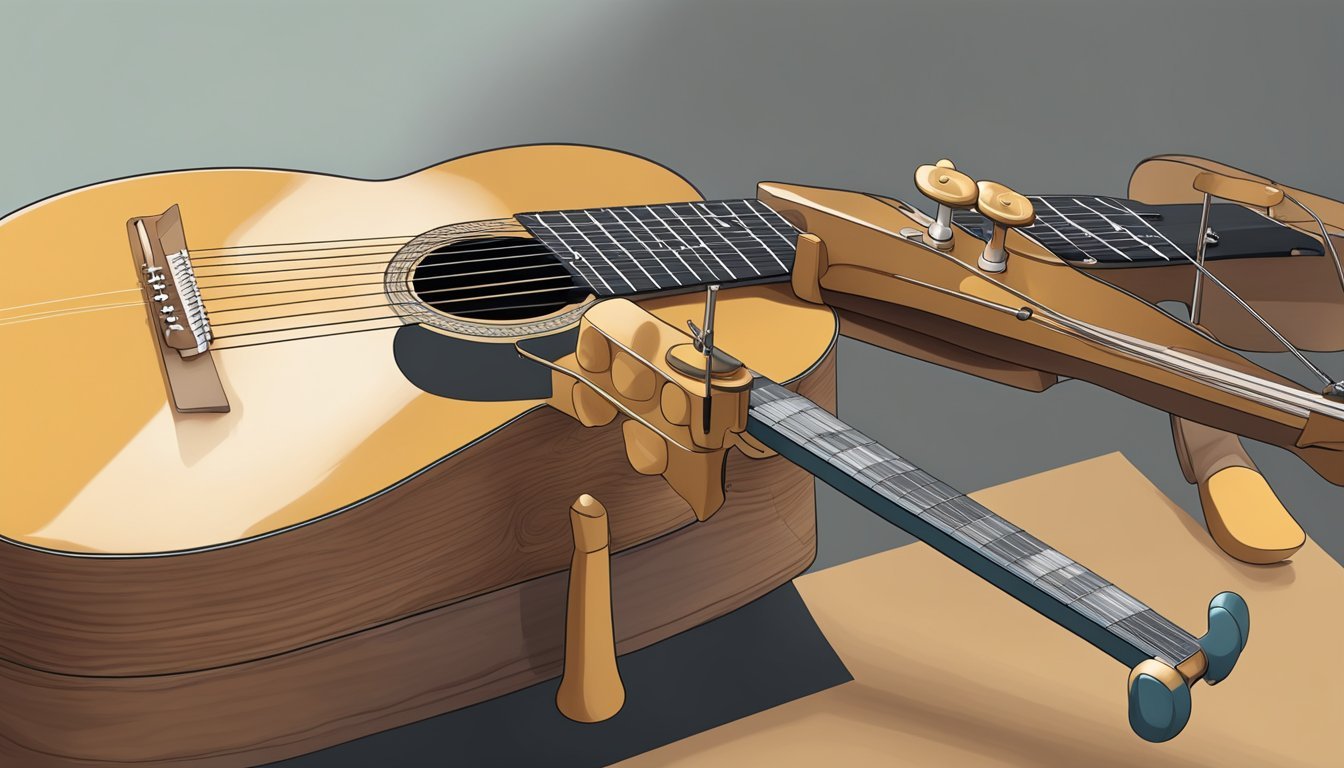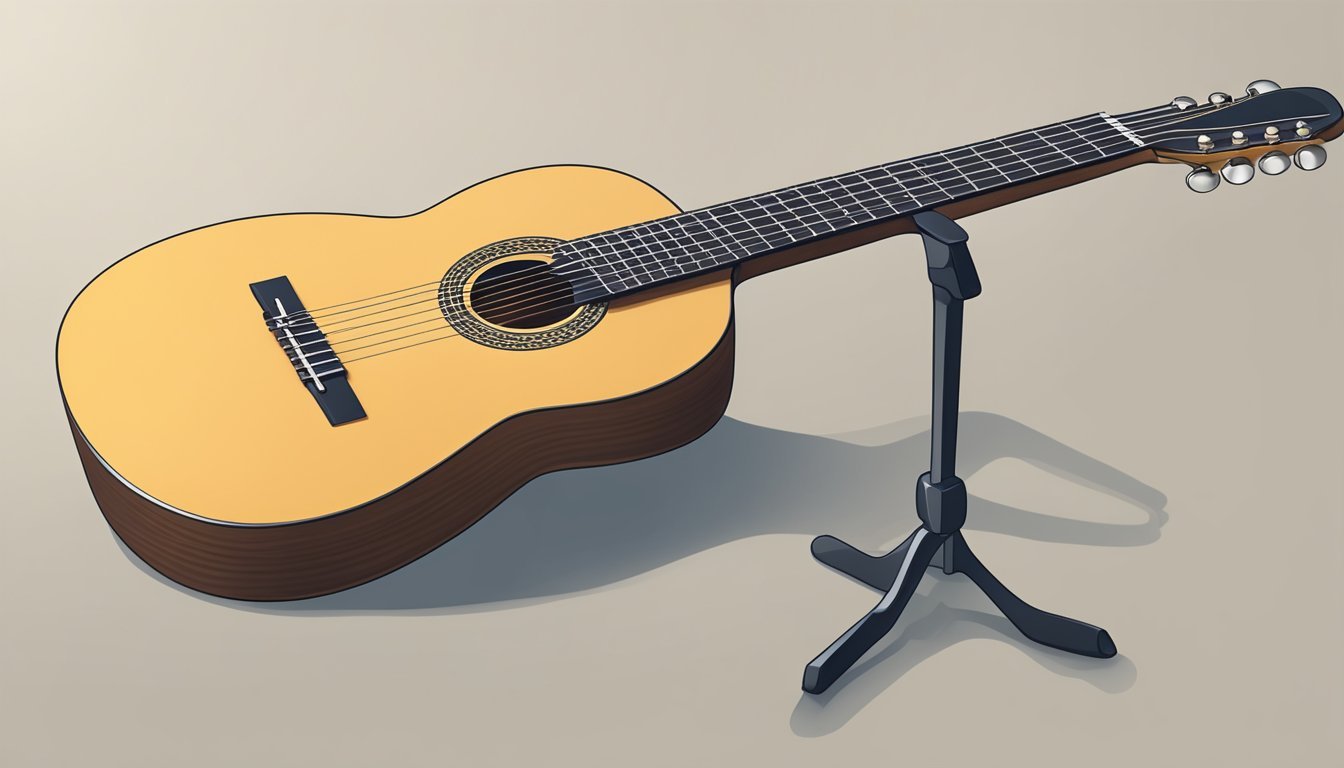Tuning a classical guitar is an essential skill for any musician.
The right techniques and tools can easily keep your guitar sounding its best, making playing a more enjoyable experience.
Whether you’re a beginner or looking to refine your skills, knowing how to tune your guitar by ear or with a tuner can elevate your playing.

Many guitarists find the process daunting, but it doesn’t have to be.
You can start by familiarizing yourself with the standard tuning of a classical guitar, which is E-A-D-G-B-E from the lowest to highest string.
As you read on, you’ll discover various methods for tuning, tips for maintaining your guitar, and answers to common questions.
All these will help you feel more confident and prepared.
Remember, tuning your guitar is just as important as practicing.
A well-tuned instrument not only sounds better but also makes it easier to learn and grow as a player.
Let’s dive into the ways you can tune your classical guitar and keep it in great shape!
Key Takeaways
- Learning to tune your guitar is crucial for an enjoyable playing experience.
- You can use different methods to ensure your guitar stays perfectly in tune.
- Regular maintenance will keep your classical guitar sounding its best.
Getting Started with Guitar Tuning
Tuning your classical guitar is essential for getting that beautiful sound you want.
Understanding the basics and preparing your guitar can make this task much easier.
To start, make sure your guitar is properly strung and that the strings are in good condition, as worn-out strings can affect your sound.
When tuning your guitar for beginners, it’s helpful to use a reliable tuner or tuning app to achieve accurate pitch.
With a bit of practice, you’ll find that tuning your guitar becomes second nature, allowing you to focus on playing and improving your skills.
Understanding the Basics of Standard Tuning
The standard tuning for a classical guitar is E-A-D-G-B-E, from the lowest string to the highest.
This means your sixth string (E) is the lowest, while your first string (E) is the highest.
When tuned correctly, the strings vibrate in a way that produces the right pitches.
Each string has a specific note that you need to match.
To aid in learning, consider using a tuning fork or an electronic tuner.
These tools help you reach the right pitch more easily.
Remember, with nylon strings, tuning can slightly vary due to stretching and temperature changes.
Regular checks will help keep your guitar in perfect shape.
Prepping Your Guitar
Before diving into tuning, ensure your guitar is ready.
Start by checking your tuning pegs on the headstock.
Make sure they turn smoothly without any resistance.
Inspect the strings for any signs of wear or damage.
Old strings can sound dull and make tuning harder.
Next, let your guitar acclimate to the room temperature.
Sudden changes can affect how strings respond.
Lastly, pluck each string gently on the body and listen closely.
This will help you notice which strings need tuning before using a tuner.
With your guitar prepped, you’ll find tuning a much smoother experience.
Tuning Techniques and Tools
When tuning your classical guitar, you have a few effective methods and tools at your disposal.
Each technique caters to different preferences, whether you like the convenience of technology or the traditional approach of tuning by ear.
Tuning with Electronic Devices
Using a digital tuner is the simplest way to get accurate sound.
These devices listen to your guitar strings and display the note each string produces.
You can choose from clip-on tuners, pedal tuners, or smartphone apps.
For a digital tuner, just pluck a string and watch its reading.
Adjust the tuning peg until the tuner shows that the string is in tune.
Tip: A metronome can be handy, too, especially if it has a built-in tuner.
It helps keep your rhythm tight while you tune.
Tuning by Ear for the Authentic Feel
If you prefer a more authentic approach, tuning by ear can be rewarding.
Start by getting one string in tune.
Many players use the 6th string (low E) to set the standard pitch.
Use a tuning fork or pitch pipe to get that first note accurate.
Once one string is tuned, you can use it to tune the other strings.
For example, place your finger on the 5th fret of the low E string.
This note is the same as the open A string.
Adjust the A string until it matches, and continue this process for the other strings.
Listening closely is key, so find a quiet space to focus.
Understanding Reference Pitches
Reference pitches provide a standard note to ensure your guitar sounds correct.
The most common standard is A440, which means the A note above middle C vibrates at 440 Hz.
Many tuners use this as the reference pitch.
You can also use a tuning fork to get an accurate A note.
Strike the fork to make it vibrate, then hold it close to your guitar.
Listen and adjust your strings to match.
Another option is a piano or pitch pipe.
If you can play the A note from these, use it to tune your guitar strings similarly.
Always aim for clarity and precision when finding those reference pitches.
Advanced Tuning Tips and Maintenance
Tuning your classical guitar involves more than just getting the right pitch.
It’s about managing string tension, fixing intonation issues, and exploring different tunings to expand your playing style.
Managing String Tension and Health
String tension is crucial for keeping your guitar in tune.
If the tension is too high, strings can break or cause unnecessary wear.
If it’s too low, you may experience tuning instability.
Tips for managing tension:
- Choose the Right Strings: Nylon strings come in different tensions: light, medium, and hard. Start with medium if you’re not sure.
- Stretch Your Strings: After changing strings, gently pull on each one to help them settle. This reduces the need for constant re-tuning.
- Check String Condition: Regularly inspect your strings for wear and corrosion. Replace them as needed to maintain tuning accuracy and sound quality.
Dealing with Intonation and Tuning Issues
Intonation refers to how accurately your guitar plays in tune along the neck.
If your notes sound off, you may have intonation issues.
To troubleshoot:
- Check with a tuner: Play the 12th fret harmonic and compare it to the fretted note. They should match.
- Adjust the saddle: If notes are sharp, shift the saddle back. If they’re flat, move it forward. This helps you achieve better intonation.
- Frequent tuning: Regularly check your tuning, especially after playing for a while. Changes in temperature and humidity can affect string tension and pitch.
Exploring Alternative Tunings
Alternative tunings can open up new musical possibilities.
Popular choices include DADGAD and Drop D.
Benefits of alternative tunings:
- DADGAD Tuning: This tuning allows for rich, open chords and is great for fingerstyle playing.
- Drop D Tuning: Lowering your sixth string gives you deeper bass notes and makes power chords easier to play.
To switch tunings, use relative tuning to ensure each string is harmonically balanced.
Experiment with these options to find what suits your style best!
Frequently Asked Questions

Tuning a classical guitar can feel tricky, especially if you’re just starting.
Here are some common questions that can help you get a better grip on tuning your instrument effectively.
What’s the best way to tune a classical guitar for a newbie?
For beginners, the easiest way is to use an electronic tuner.
These tuners are simple and provide a visual guide to help you tune each string.
Just pluck a string, and the tuner will indicate which way to adjust it.
Can you tune a classical guitar without any fancy gadgets?
Absolutely! You can tune your classical guitar using a reference pitch, like an online tuner or a tuning fork.
Just match each open string to the correct pitch, and you’re good to go.
What’s the trick to tuning a classical guitar using a tuner?
When using a tuner, make sure to pluck the string gently and allow the tuner to get a stable reading.
Adjust the string until the tuner shows it’s in tune.
It’s a quick way to ensure accuracy.
Is there a way to tune a classical guitar by ear, and how accurate is it?
Yes, you can tune by ear! Start with the low E string and tune the other strings relative to it.
While this method is less precise than using a tuner, with practice, you can get quite good at it.
Are there any good apps for tuning my classical guitar?
Yes, many tuning apps are available, such as GuitarTuna or Pano Tuner.
These apps are easy to use and can help you quickly tune your guitar with just your phone.
Do classical guitars often go out of tune, or is it just me?
Classical guitars, especially new ones, often go out of tune.
Changes in temperature and humidity can also affect tuning.
Regular tuning checks can help keep your guitar sounding great.

